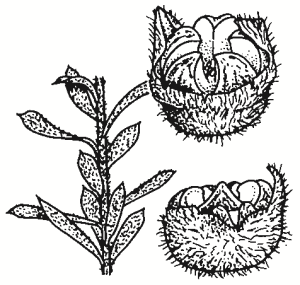Family:
Myrtaceae
Leptospermum lanigerum
Woolly Tea-tree
Other Names:

Name Origin:
Leptospermum — from Greek leptos, slender, and sperma, seed, referring to narrow seeds of some species.
lanigerum — from Latin lana, wool, and gerus, bearing, referring to woolly flower parts.
Regional Subspecies:
Occurrence:
Regional:
Noted only in Upper Gilmore. Possibly also in similar country nearby.
Australia:
NSW, Vic, Tas, SA.
Habitat:
Open eucalypt communities, sandy swamps and along watercourses.
Habit:
Erect, dense tall shrub to over 5 m high. Smooth bark and often silvery new growth.
Site Preference:
Moist soil. Tolerates most frost, and a range of acidic to alkaline soils. Tolerates heavy, poorly- drained soil.
Characteristics:
Very hardy. Moderate growth rate. Lifespan up to several decades.
Flowering:
White, Oct-Jan. Prolific.
Seed Collection:
Any time. Seeds retained for many years, and shed after adversity such as injury, drought or fire. Collect capsules from older wood. Seeds highly viable, remaining so for many years in storage.
Propagation:
From seed or tip cuttings, which strike readily. Sow light scattering of seed and cover lightly. Germinates in 2-5 weeks. Capillary watering should benefit fine seed. Suitable for direct seeding into pots. Smoke treatment enhances germination.
Regeneration:
From seed, dispersed by wind and water. Regenerates well along creeks and rivers and in swampy areas.
VALUES:
Shade & Shelter:
Excellent low-level cover in windbreaks.
Land Protection:
Excellent in controlling creekside and gully erosion due to soil-binding fibrous roots. Branches root when contact made with moist soil.
Wildlife:
Excellent habitat. Foliage excellent refuge for small birds, particularly in dense thickets. Flowers are a good pollen and nectar source for many native insects, including moths and butterflies. Insect-eating birds attracted.
First Nations:
Implements made from stems, including pegs for kangaroo skins, hunting spears and eel spears.
Ornamental:
Attractive for screening, hedges, pond edges and bog gardens. Shallow roots do not interfere with footpaths or utilities. Tip prune regularly to encourage bushy growth.
Other:
Used in colonial medicine.
